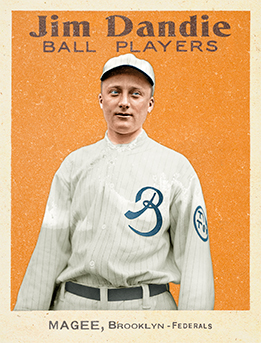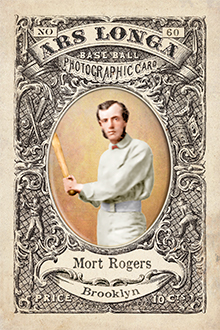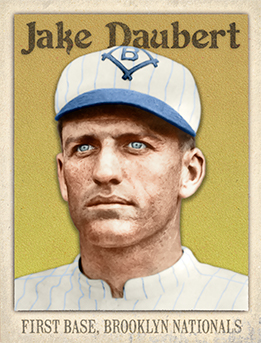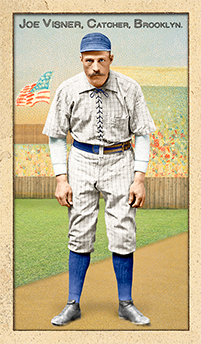
- Series: Jim Dandie Feds
- City: Brooklyn
- Team: Tip-Tops
- League: Federal League
Leo Christopher Magee (1889-1966) started his major league career in dramatic fashion as he and his Cardinal teammates helped rescue dozens of fellow passengers when their train wrecked in Connecticut. His manager Roger Bresnahan liked what he saw despite Magee's weak hitting, putting him in for the injured Miller Huggins at second and then moving him to left where he acquired the nickname “Flash.” Magee finished that 1911 season with a much improved batting average--.290--good for third on the team. Leo was a hothead, encountering numerous run-ins with umpires, squabbling with management over salary and even getting ejected mid-game for fighting—with teammate Ted Cather. Nevertheless, or perhaps because of his fiery style, John McGraw chose Magee as a member of a world-tour exhibition competing with Charles Comiskey's American Leaguers. He showed his flair for the dramatic could work on the field in a match in Medford, OR, when in pouring rain, he glided toward the line in left to make a grab while carrying an umbrella. The teams ended their circumnavigation of the globe aboard the Lusitania after their last games in England in March 1914. He was courted by the new Federal League Chicagos but remained with Mordecai Brown's Terriers for a fine season before finally jumping to the Brooklyn Tri-Tops in '15 where he also became, at 25, one of the youngest managers. He wasted no time demonstrating his temper, getting ejected in the first inning of the home opener. The experiment of trying such a youngster in the pilot's role failed as Lee's tough style alienated his veteran players and fans alike. His skill at bat and afield caused old mate Huggins, now managing the Yankees, to bring Magee aboard for the 1916 season. Huggins termed Lee “the prize of the Federal League collection.” Salary disputes, unsavory associations and union activity all combined to cast a long shadow over Magee's latter years. Finally, in 1919, he was ousted from the game with Hal Chase for allegations of throwing a game.
- Despite a fine career average of .276 in nine seasons, Magee's tenure ended ignominiously due to a jury verdict that proved the precursor to MLB's crusade against gambling which culminated the next year in the Black Sox affair

- Series: Pioneer Portraits I: 1850-1874
- City: Brooklyn
- Team: Resolute BBC
- League: National Association (NABBP)
Maxson Mortimer Rogers (1845-1881) had a profound impact on both the national pastime and the innovation of the baseball card. Unfortunately, his unique contributions have been largely lost to memory and obscured by history.
Rogers began his sporting life as a cricketer and, by the mid 1860s, had become a prominent star baseball player and executive for Civil War era teams such as the Resolute BBC of Brooklyn. By 1864, Rogers was secretary of the NABBP, baseball’s first professional league, and was elected the league’s first vice-president in 1867.
As a professional printer and entrepreneur, Rogers self-published a weekly sports paper called the New England Chronicle from 1869-1870, devoting substantial ink to the developing game he loved.
By 1871, Rogers was umpiring NABBP games in Boston while self-printing and selling “Base Ball Photographic Cards” at the games for .10 cents a piece (the price was later dropped to .05 cents). Rogers’ stated ambition was to produce a card for every prominent player in the country, but as so few of his cards exist today it is difficult to know the exact diversity or quantity of cards he was able to produce.
The Mort Rogers’ Scorecards were foldable scorecards with an image of a baseball player on the front pane (including the player’s name, position and team), a scorecard in the center two panes for that day’s game, and a group of advertisements on the rear pane. Rogers produced and sold the cards from 1871-1872.
Although there is still great debate over which card or set of cards should be considered the very first, a solid case can be made to declare Mort Rogers the Father of the Baseball Card. Ars Longa pays homage to Rogers’ legacy with this very Pioneer Portraits I series of art cards.
- A testament to his playing prowess is Mort’s inclusion in an 1865 woodcut in Frank Leslie’s Illustrated Newspaper depicting the “leading players” among NYC clubs (The woodcut includes a black-shrouded Jim Creighton in memoriam and an unidentified non-player thought to be Henry Chadwick)
- Mort’s younger brother Fraley Rogers was an early star in NY and Boston, but had an ill-starred fate as the first pro player to take his own life, at age 30, three days before Mort’s death
- Historian John Thorn, who has done groundbreaking work on contenders for “earliest baseball cards,” honors and cites Rogers’ work as the “first numbered set”
- In Mort’s honor, his Ars Longa card is numbered 60, the last in the set. The complete set will be numbered 1-58 & 60 with number 59 omitted from the series to represent the original Mort Rogers' Scorecards that are likely lost to us.

- Series: 1880s: Diamond Duos
- City: Brooklyn
- Team: Bridegrooms
- League: American Association
Bob Clark:
Robert H. Clark (1863-1919) cut his teeth in the fierce baseball rivalries between his native Covington KY and neighboring Cincinnati. He was enjoying a fine rookie season with Atlanta but caught the attention of the scouts when he was dragooned into catching after an injury to the starter. Bob came up with Brooklyn in 1886 and found great success there, handling all the staff. Bob was praised by the NY Clipper in ‘88 as one of the Bridegrooms’ most valuable players. During his five seasons in NY Clark hit a fine .241, but saw his average plunge after leaving Brooklyn in ‘91 for part time duty with Cincinnati and Louisville for one year with each club. Undoubtedly, Clark’s career highlights were the two Brooklyn pennants, first in ‘89 in the American Association and the following year when the franchise joined the National League.
- Clark died tragically from a fire back home in Covington at age 56
Mickey Hughes:
Michael J. Hughes (1866-1931) got 25 of his three-year career total 39 wins for the Brooklyn Bridegrooms in his rookie season, 1888. That performance earned Hughes the opening day start for Brooklyn in 1889, but he fell to a lackluster 9-8 record that year. Hughes was traded to the Athletics in 1890, finishing his brief ML tenure going 1-3 in six games.
- In Brooklyn’s final year in the American Association, Hughes went 1-0 in the 1889 Series against the NY Giants, won by NY 6 games to 3
Auction History
Cartophilia
Old Judge Pose: 76-6
- Series: Diamond Heads '15
- City: Brooklyn
- Team: Robins
- League: National League
Jacob Ellsworth Daubert (1884-1924) is considered by some the best first-baseman NOT in the Hall. His fielding was never below .989, he led the NL in batting 1913 & ’14, and was MVP in ’13. Seven times from 1911-19 he was named to Baseball Magazine’s All-America team. Popular with players and fans, his union activity alienated management.
- Charles Ebbetts sent him from Brooklyn to the Reds in 1919 following a salary dispute
- Became ill and died during his final road trip with the Reds in 1924
- Series: Beginnings: 1880's
- City: Brooklyn
- Team: Bridegrooms
- League: American Association
Joseph Paul Visner (1859-1945). An outfielder and catcher over 4 major league seasons for 5 different teams, Visner was one of the few Native Americans to play professional baseball in the 19th century. His best year was 1890 for the Pittsburgh Burghers, when he hit .267, with 22 triples, 76 BB, 71 RBI, and scored 110 Runs.
- Won a pennant with the Brooklyn Bridegrooms in 1889




